What is an Example of Value Stocks?
A value stock is an asset whose price falls below its intrinsic value and can be bought in the market at a discount. A stock can be undervalued today, but then overvalued months or even days later. Here are some historical examples of undervalued stocks.
A stock’s valuation changes every day; hence we can only provide historical examples of stocks that were overvalued or undervalued.
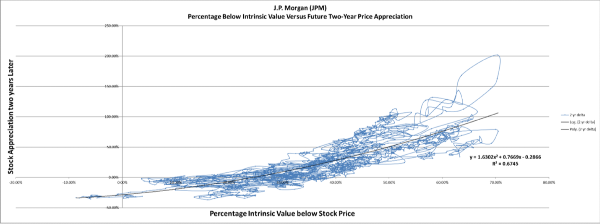
JP Morgan is a stock that is loved by value investors due to its consistency and growth. The stock has had consistent growth for over a decade. In the chart below, earnings per share has steadily grown since 2009 when the financial crisis was winding down.
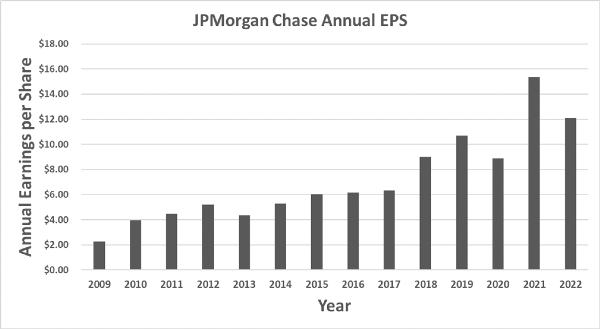
Based on a discounted earnings valuation process, JP Morgan has also steadily grown its intrinsic value over time. While earnings have grown, so to has the stock’s book value per share.
This has led to the company’s intrinsic value to steadily increase over time, which its stock price tends to follow.
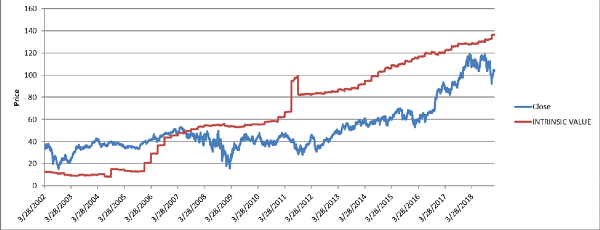
The stock price of Southern Company follows the intrinsic value of the stock quite well, with recent moves of SO lining up with its intrinsic value back in 2022.
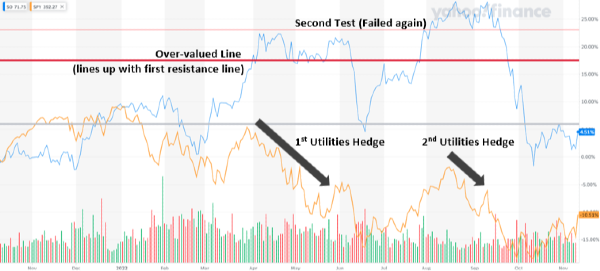
Historically, Southern Company’s price follows its intrinsic value closely. The variance from intrinsic value has a weak correlation to 2-year price appreciation.
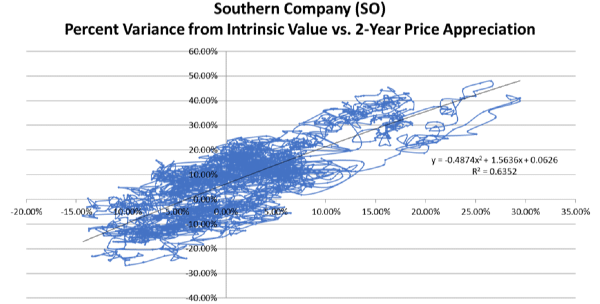
This can be seen better in a graph of Intrinsic value compared to stock price over time. The stock price of Southern Company will revert to the intrinsic value given enough time.
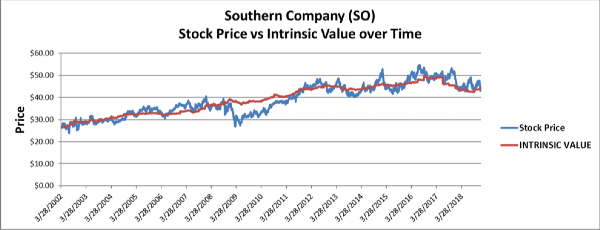
Boeing for years followed its intrinsic value up until 2017. Interestingly enough, investors started to raise their guidance for Boeing due to its extensive increase in backlog. However, Boeing is a manufacturer that needs time to create new production lines to meet this demand. Hence while its sales backlog increased, its earnings weren’t following the same path. Hence, Boeing’s stock price started to deviate substantially from its intrinsic value.
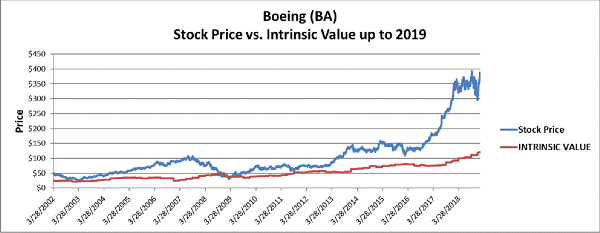
Looking at the discrepancy between Boeing’s stock price versus its intrinsic value, you would think that it was due for a correction. It did finally happen, but it took Covid-19, a black swan event, to make the stock price finally revert back to the stock’s intrinsic value.
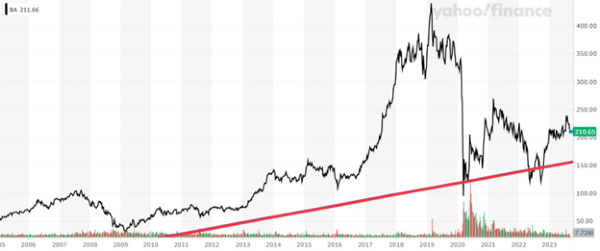
Two more corrections in 2022 again show that the intrinsic value of Boeing is the floor for the stock price. In this case, it represents how far the stock price will correct to.
Growth vs Value Investing
Growth investing focuses on stocks that can scale their revenue and earnings, causing a rapid growth in intrinsic value. Value investing prefers stocks that are already established, have a moat, and have a consistent growth strategy.
With growth investing, you have the potential for faster gains. This is because the intrinsic value of the company is rising rapidly. However, the trade-off is that the intrinsic value will be volatile, hard to measure or predict, and the market will significantly overprice or underprice the stock due to the inherit fog-of-war.
As Tayo Femi-Fowode noted, value investing and growth investing are very similar. Both growth and value investors are looking to buy companies below what they are worth.
Value versus Growth Investing at a Glance

Growth Investing
- Intrinsic value rapidly growing.
- Intrinsic value volatile.
- Higher chance of overvaluation.
- Company is disruptive.
Value Investing
- Intrinsic value growing steadily.
- Intrinsic value more predictable.
- Higher chance of undervaluation.
- Company established, has moat.
Similarities Between Growth and Value Investing
Value investing and growth investing both look at the company fundamentals to determine if the company should be bought. This is in contrast with momentum investing and technical analysis, which are indifferent to the underlying asset.
Both strategies want to buy stocks that the market has undervalued. The strategies presume the market has not valued the company properly and considered its full potential. This again is in sharp contrast to momentum investing. In momentum investing, the investor is indifferent to whether the company is overvalued. The momentum investor will hold a stock as its price appreciates from a fair value to being overvalued.
Finally, both are successful strategies if implemented with a long-term horizon in mind. Value investing may take a minimum of 2-years for the market to revert a stock price back to its intrinsic value. A growth investor will want to ride the exponential growth of a stock. This could mean holding a stock for a decade before selling.
Differences Between Growth and Value Investing
The key difference between growth and value investing is the risk versus reward profile of the investments being undertaken. Growth companies have more potential for exponential return; however, this is balanced by many unknowns. Symptoms of these unknowns include negative earnings, cash burn, and revenue uncertainty.
Value investing focuses on companies with predictable earnings and cashflow growth. Value investors wait for stocks to be undervalued, then buy the company low, and reap the reward when the stock price reverts to the company’s intrinsic value.
These risk versus reward profiles are driven by the growth and volatility of the company’s intrinsic value. The intrinsic value of a value investment will typically grow upwards at a steady pace. The intrinsic value will not be relatively straightforward to estimate.
A growth company could see rapid growth or collapse of its intrinsic value. A growth company may see a rapid growth in sales, or a rapid burn of cash. Both situations could lead to an intrinsic value being too elusive to be calculated.
Growth vs Value Stocks Examples
Examples of value stocks include:
These stocks have relatively predictable intrinsic values that are growing steadily.
Examples of growth stocks include:
Amazon and Alphabet have matured over the years. Overtime, they could be considered value investment opportunities as their revenue, earnings, and cashflow become more predictable.
Roblox is an example of a true growth stock. Though the stock has been in business for decades, its recent IPO has opened its books to the public. Their revenue is still volatile, but they also have ambitious growth projects in the next decade.
Value Investing by Sector
Traditionally, some sectors have been considered growth investments, while others are considered value investments. As time goes on though, these traditions have been breaking down as companies blur the lines of what sector they belong in.
For example, the technology sector is typically the bastion of growth stocks. But in recent years, established tech companies like Amazon and Alphabet have become more predictable in terms of their growth. Warren Buffett, the poster child of value investing, has a significant position in Apple.
On the flip side, the surge in interest in space has changed the opportunities in the industrial sector. Industrials typically have predictable earnings and revenue. However, the race of the private sector into space has completely redefined revenue growth opportunities for industrial stocks. Some industrial stocks even blur the line between what a technology stock and industrial stock is.
This can be seen heavily with electric vehicles. Tesla has blurred the lines between an industrial stock and a technology stock. But as it continues to disrupt the vehicle market, Tesla continues to be a growth stock.
Are Banks Considered Value Stocks?
Bank stocks are traditionally value investment opportunities. JPM is a classic example. However, as the financial sector fuses with the technology sector, some banks are using technology to disrupt the industry. Many of these companies have huge growth opportunities.
Are Utilities Considered Value Stocks?
Utilities are traditionally value investment opportunities as well. There are exceptions however. Some utilities, like Consolidate Water (CWCO), act more like growth stocks. Consolidated water provides desalination processes in places like the Bahamas. Their revenue has accelerated in recent years thanks to more growth opportunities. As their revenue is rapidly changing, there’s an argument to be made that the company is more like a growth stock.
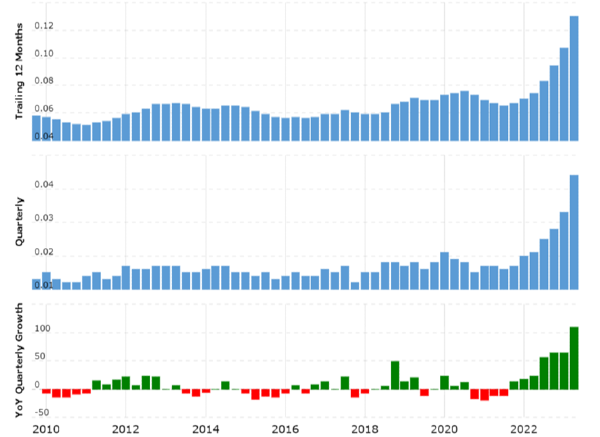
Best Undervalued Stocks Right Now
A stock’s valuation changes every day; hence we showcased only historical examples of stocks that were overvalued or undervalued. To see a list of potentially undervalued stocks right now, check out our top undervalued stocks list.
https://youtu.be/GcwG-IhkDDc
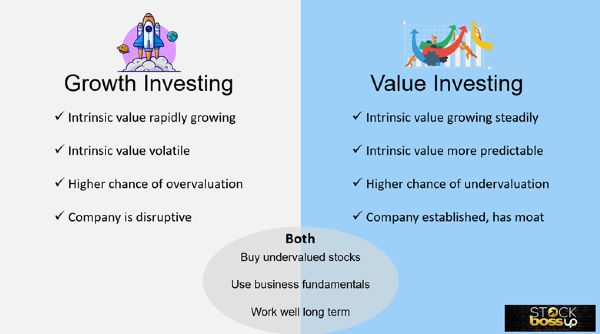

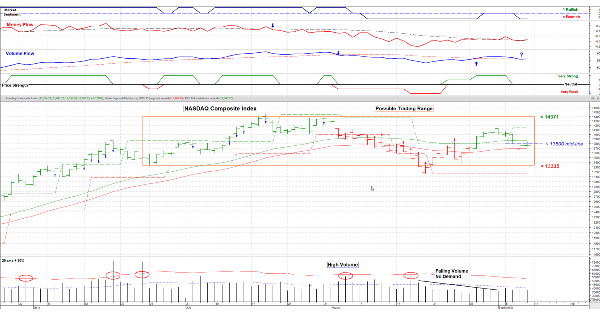


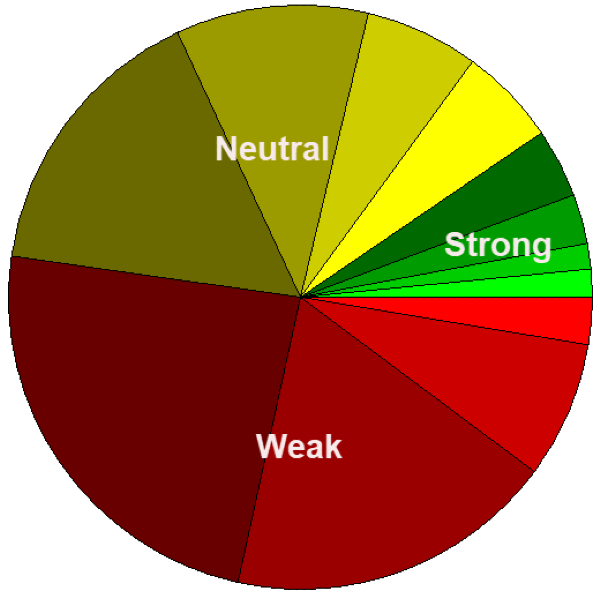
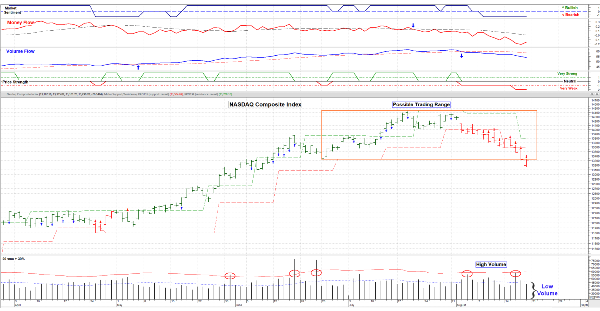
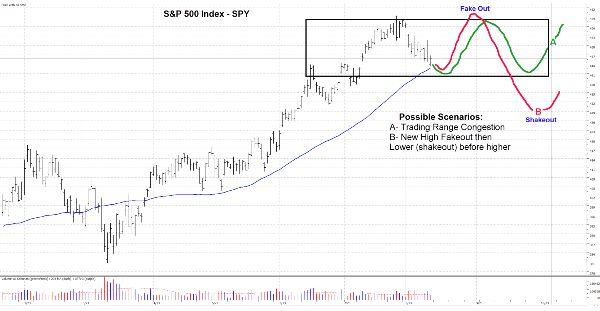




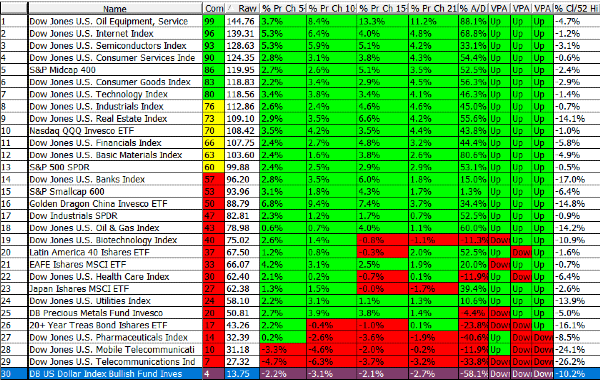
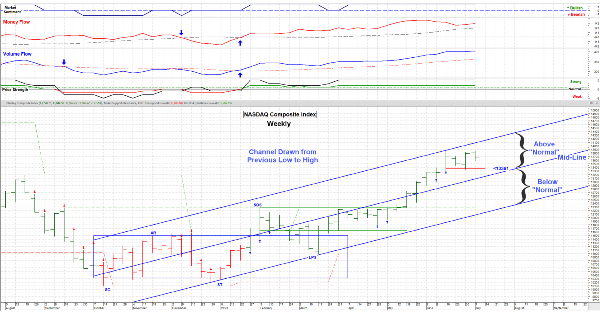
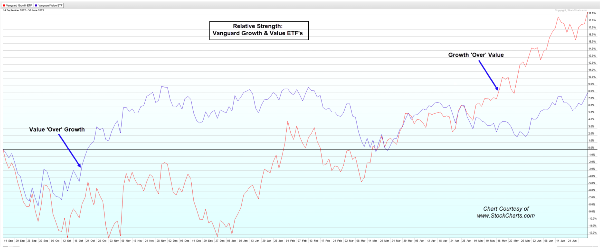
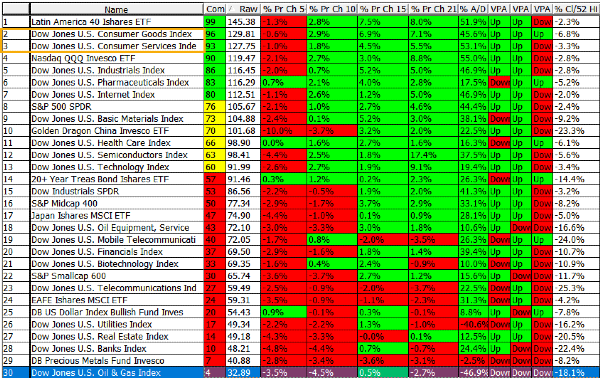
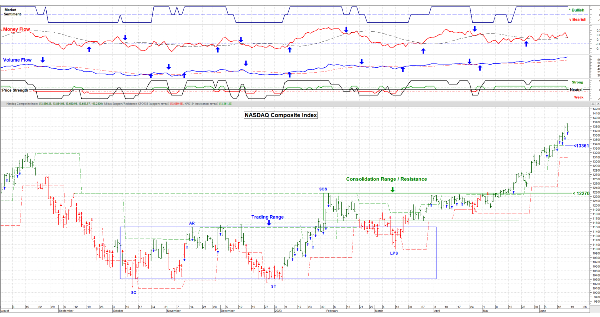

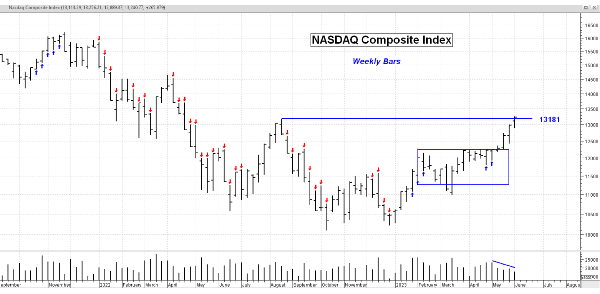
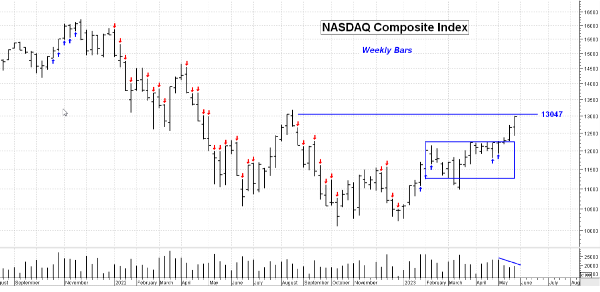

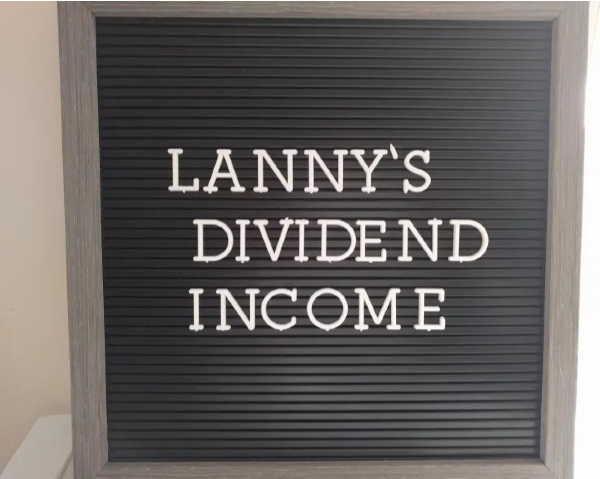








What is an Example of Value Stocks?
A value stock is an asset whose price falls below its intrinsic value and can be bought in the market at a discount. A stock can be undervalued today, but then overvalued months or even days later. Here are some historical examples of undervalued stocks.
A stock’s valuation changes every day; hence we can only provide historical examples of stocks that were overvalued or undervalued.
JP Morgan (JPM)
JP Morgan is a stock that is loved by value investors due to its consistency and growth. The stock has had consistent growth for over a decade. In the chart below, earnings per share has steadily grown since 2009 when the financial crisis was winding down.
Source macrotrends.com
Based on a discounted earnings valuation process, JP Morgan has also steadily grown its intrinsic value over time. While earnings have grown, so to has the stock’s book value per share.
This has led to the company’s intrinsic value to steadily increase over time, which its stock price tends to follow.
Southern Company (SO)
The stock price of Southern Company follows the intrinsic value of the stock quite well, with recent moves of SO lining up with its intrinsic value back in 2022.
Historically, Southern Company’s price follows its intrinsic value closely. The variance from intrinsic value has a weak correlation to 2-year price appreciation.
This can be seen better in a graph of Intrinsic value compared to stock price over time. The stock price of Southern Company will revert to the intrinsic value given enough time.
Boeing Company (BA)
Boeing for years followed its intrinsic value up until 2017. Interestingly enough, investors started to raise their guidance for Boeing due to its extensive increase in backlog. However, Boeing is a manufacturer that needs time to create new production lines to meet this demand. Hence while its sales backlog increased, its earnings weren’t following the same path. Hence, Boeing’s stock price started to deviate substantially from its intrinsic value.
Looking at the discrepancy between Boeing’s stock price versus its intrinsic value, you would think that it was due for a correction. It did finally happen, but it took Covid-19, a black swan event, to make the stock price finally revert back to the stock’s intrinsic value.
Source: Yahoo! Finance
Two more corrections in 2022 again show that the intrinsic value of Boeing is the floor for the stock price. In this case, it represents how far the stock price will correct to.
Growth vs Value Investing
Growth investing focuses on stocks that can scale their revenue and earnings, causing a rapid growth in intrinsic value. Value investing prefers stocks that are already established, have a moat, and have a consistent growth strategy.
With growth investing, you have the potential for faster gains. This is because the intrinsic value of the company is rising rapidly. However, the trade-off is that the intrinsic value will be volatile, hard to measure or predict, and the market will significantly overprice or underprice the stock due to the inherit fog-of-war.
As Tayo Femi-Fowode noted, value investing and growth investing are very similar. Both growth and value investors are looking to buy companies below what they are worth.
Value versus Growth Investing at a Glance
Growth Investing
Value Investing
Similarities Between Growth and Value Investing
Value investing and growth investing both look at the company fundamentals to determine if the company should be bought. This is in contrast with momentum investing and technical analysis, which are indifferent to the underlying asset.
Both strategies want to buy stocks that the market has undervalued. The strategies presume the market has not valued the company properly and considered its full potential. This again is in sharp contrast to momentum investing. In momentum investing, the investor is indifferent to whether the company is overvalued. The momentum investor will hold a stock as its price appreciates from a fair value to being overvalued.
Finally, both are successful strategies if implemented with a long-term horizon in mind. Value investing may take a minimum of 2-years for the market to revert a stock price back to its intrinsic value. A growth investor will want to ride the exponential growth of a stock. This could mean holding a stock for a decade before selling.
Differences Between Growth and Value Investing
The key difference between growth and value investing is the risk versus reward profile of the investments being undertaken. Growth companies have more potential for exponential return; however, this is balanced by many unknowns. Symptoms of these unknowns include negative earnings, cash burn, and revenue uncertainty.
Value investing focuses on companies with predictable earnings and cashflow growth. Value investors wait for stocks to be undervalued, then buy the company low, and reap the reward when the stock price reverts to the company’s intrinsic value.
These risk versus reward profiles are driven by the growth and volatility of the company’s intrinsic value. The intrinsic value of a value investment will typically grow upwards at a steady pace. The intrinsic value will not be relatively straightforward to estimate.
A growth company could see rapid growth or collapse of its intrinsic value. A growth company may see a rapid growth in sales, or a rapid burn of cash. Both situations could lead to an intrinsic value being too elusive to be calculated.
Growth vs Value Stocks Examples
Examples of value stocks include:
These stocks have relatively predictable intrinsic values that are growing steadily.
Examples of growth stocks include:
Amazon and Alphabet have matured over the years. Overtime, they could be considered value investment opportunities as their revenue, earnings, and cashflow become more predictable.
Roblox is an example of a true growth stock. Though the stock has been in business for decades, its recent IPO has opened its books to the public. Their revenue is still volatile, but they also have ambitious growth projects in the next decade.
Value Investing by Sector
Traditionally, some sectors have been considered growth investments, while others are considered value investments. As time goes on though, these traditions have been breaking down as companies blur the lines of what sector they belong in.
For example, the technology sector is typically the bastion of growth stocks. But in recent years, established tech companies like Amazon and Alphabet have become more predictable in terms of their growth. Warren Buffett, the poster child of value investing, has a significant position in Apple.
On the flip side, the surge in interest in space has changed the opportunities in the industrial sector. Industrials typically have predictable earnings and revenue. However, the race of the private sector into space has completely redefined revenue growth opportunities for industrial stocks. Some industrial stocks even blur the line between what a technology stock and industrial stock is.
This can be seen heavily with electric vehicles. Tesla has blurred the lines between an industrial stock and a technology stock. But as it continues to disrupt the vehicle market, Tesla continues to be a growth stock.
Are Banks Considered Value Stocks?
Bank stocks are traditionally value investment opportunities. JPM is a classic example. However, as the financial sector fuses with the technology sector, some banks are using technology to disrupt the industry. Many of these companies have huge growth opportunities.
Are Utilities Considered Value Stocks?
Utilities are traditionally value investment opportunities as well. There are exceptions however. Some utilities, like Consolidate Water (CWCO), act more like growth stocks. Consolidated water provides desalination processes in places like the Bahamas. Their revenue has accelerated in recent years thanks to more growth opportunities. As their revenue is rapidly changing, there’s an argument to be made that the company is more like a growth stock.
Source macrotrends.net
Best Undervalued Stocks Right Now
A stock’s valuation changes every day; hence we showcased only historical examples of stocks that were overvalued or undervalued. To see a list of potentially undervalued stocks right now, check out our top undervalued stocks list.
https://youtu.be/GcwG-IhkDDc